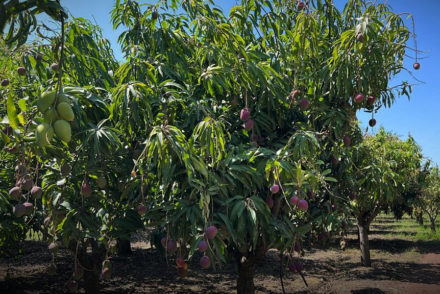It’s complicated depending on who you ask…..
Currently Crespo Organic is on the downside of peak of Kent season from Sinaloa. The Nayarit region has finished and all packhouses in that region have closed. Our orchards in Sinaloa, which dot the surrounding area of our hometown El Rosario and encircle our main packhouse, Empaque Don Jorge, are brimming with ample volumes and varied sizes. We are currently harvesting Kent mangoes and, in a few weeks, will be harvesting Mexico’s final variety- the Keitt. The best news to report is that the outstanding quality we have seen all season long is currently looking to trend the same through most of August, more than that, I find the foretelling of the end of the Mexican mango season difficult.
As we move into the final part of the Mexican season, everyone wants to know, or thinks they know- what will happen next.
The truth is, I, like others don’t really know much. I have found, all too often, in particular this season, fruit future telling is complicated and very much depends on who you ask and more often than not predications (lately) turn out to be wrong or at least sort of wrong.
I tend to focus on pattern finding in order to settle as close to facts that I can use to gauge the road ahead in order to decide how exactly to maneuver through the last few months of the season. The organic side is complex and the end of the season even more so, smart decisions at this point are necessary to end the season with happy customers.
Mexico’s season ends in the Sinaloa region sometime between the end of August and the end of September. This time of year we are besieged with industry “expert” misconceptions, mis information and inaccurate interpretations of the facts. Organic and conventional details are often (wrongly) lumped into one- “the mango category”, which might work in parts of the season, but not the ending. Kent and Keitt varietals typically yield much larger sizing and because of this the organic facts become more important as both the gap between organic and conventional pricing begins to increase greatly and rapidly and organic production volumes dwindle. Fruit price mathematics begin to play a crucial role as regional production shifts into the Los Mochis region and Keitt mangoes, where fruit can often yield 5-6 and 7cnts on average become the norm.
When foretelling the end of the Mexican season it’s important to clarify that there are two distinct sub-regions in Sinaloa, which operate simultaneously during late July and early August. The El Rosario and surrounding area- where we are currently picking and packing and anticipate doing do for another 3 weeks- is a designated fruit fly zone, by USDA APHIS; which means all the fruit must under-go hydro-thermic treatment in order to be imported into the USA.
Check out the entire mango packing process in this quick and detailed video.
The other region, which is most often referred to as the Los Mochis area, is sanctioned a fruit fly free zone by APHIS- which means no treatment is necessary for import into the USA. This region, technically, according to the USDA is called Sinaloa de Leyva- which is about an hour’s drive from the city of Los Mochis, where the mangoes in the region are produced.
This northern fruit fly free area is about 200-250 miles from the Rosario area, not much space in between. In terms of organic producers, the majority of producers stay longer in the fruit fly zone, where there is more Kents and more retailer friendly sizing on the sub-regions Keitt mangoes (most seasons, including this one). In the Los Mochis area there are some Kent mangoes as well but mostly they produce the late season Keitt mangoes and normally the sizing is very large, deepening on the weather.
This season, in both these sub regions, like the rest of the regions, climate has been irregular. Currently the fruit is a lot smaller than average, due to the lack of rain and heat. Recent rains in El Rosario area has made some of the Kent varietals size up, giving way to a much more even size variance than we saw at the onset of Kent season, which yielded predominantly 10 -12cnts on both the organic and conventional circuits. Some Rosario growers are still reporting small fruit (10 & 12cnts) on the OG and CV side- despite the rain. Kent mangoes in this sub region are expected to run another few weeks with excellent quality and sizing options and then the area will begin its Keitt season, which is expected to yield again, more retail prized sizing 8/9/10 with a great proportion of larger size options as well — 6 and 7cnts. Since the fruit is predicted to yield a bit smaller than average in this sub-region – it will be good for wholesalers and retailers who pull from grower/packers like Crespo who have significant fruit volumes in this area.
Eventually everyone, including Crespo, will move into Los Mochis where all will finish off the Mexican season. The expectation varies by conventional and organic production. What is true is there is a lot of fruit in Los Mochis this year, and like most years, its conventional. Remember, in an average year the sizing is so big that the organic price becomes too high for the mass markets and they either reduce or eliminate the organic offering- until Ecuador’s organic starts up in November typically (sometimes October). So if gigantic predications are true, we expect organic demand to dwindle as the math won’t work for many of the large format retailers. It will be interesting to see what the market can bear as we head into September. It is true that organic demand is higher than ever after all. additionally on the organic side of the equation, there is simple less fruit and most growers, and I am not sure why, are reporting having less fruit on their trees, despite conventional growers reporting more, which honestly confuses me.
On the conventional side, the intel varies drastically in terms of what will happen. I hear over and over and over from the large packing houses there is a lot of fruit moving (and there are a lot of very large packing houses in Los Mochis- since they don’t need the hydro-thermic operations it’s much easier to maintain a packaging operation and a big one at that) Most of the fruit packed from Los Mochis so far has been Kents and smaller than average sizing 7/8/9 with way more 10 and 12’s than usual. Some Keitts have started as well. The expectation for the Keitt varietal from Los Mochis is that it will grow big (as usual) – 4/5/6’s. This is the part where my pattern mind takes a pause- since there has not been any fruit this season that has grown big as usual. But to be fair, we haven’t seen the Keitts yet this season and what is true is that every varietal behaved differently unlike the other so who knows.
Whatever the size that comes, the area, which has experienced a significant increase in (mainly conventional) production over the last 5 years is expected to have better than average yields in general due to excellent flower formation and weather during fruit set.
On the organic side a few important things to consider for the season ending.
- Lower regional production than prior regions/sub-regions.
- Larger sizes then the organic market enjoys.
- Organic dried mango sector- consumes large quantities of the Keitt varietal, especially from this region and typically pays excellent prices. The dried sector prefers the Keitts for the near fiberless flesh.
- Weather related quality issues. Once the rains start coming anthracnose often sets in, especially with hot humid weather. Hot water baths can often quell the rapid spread of anthracnose- but since this region doesn’t have the hydro-thermic treatment it can often be a messy ending.
Another important reminder before we head into Mexican Keitt season: Mexican Keitts look much different than the California ones- read more about that on my post– What the Blush?
In general it’s too early to tell how long the season will last, another area of dispute between industry “experts”. Most seasoned producers know that the rain and temperatures during the rain, combined with humidity levels, will dictate the quality and thus the season ending.
The past few seasons the season has run particularly long, especially with several new orchards planted specifically to capture this late window and drastic regional climate changes expand the season beyond what it used to be and it becomes drier and warmer, longer. What is certain and what is the predominate language the most in the business speak is that everything these days is unpredictable.
If recipes are more your thing rather than forecasting, head over to my latest blog post featuring some revamped mango recipes that I used for a cooking mango cooking class at the Sacramento Natural Foods Coop this past weekend.












No Comments